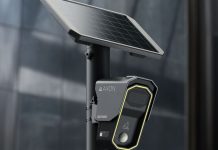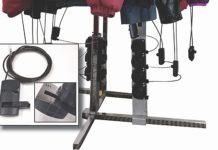Retail crime remains one of the most serious threats facing the retail industry. Shrink, otherwise known as a reduction in inventory due to shoplifting, employee theft, or other errors, significantly impacts a retailer’s bottom line—to the tune of nearly $100 billion annually in direct losses worldwide. Regardless of where retail operations are located, shrink is a universal foe. That’s why retailers need to know what electronic article surveillance (EAS) technologies are in the tool box to win.
EAS is an important defense against the rise of casual and organized retail theft. Traditional approaches to help solve retailers’ shrink challenges include acousto-magnetic (AM) and radio-frequency (RF) technologies developed for EAS. Retailers are also leveraging radio-frequency identification (RFID) technology for loss prevention. When it comes to protecting the bottom line, retailers need to understand and overcome the complexities of implementing an EAS system optimized for their product range, store layouts, and business goals.
The strengths and weaknesses of each approach depends on its underlying technology, in particular on the frequency and frequency band used to detect anti-theft tags and labels. No single technology will meet the requirements of every retailer. But whether a retailer wants to implement traditional EAS or apply RFID technology to EAS, options are available for retailers to explore their benefits and limitations in order to decide which can best meet their loss prevention goals.
The Technical Explanation
 All EAS technologies rely on electronic communication between a controller (or reader) that sends an electromagnetic signal and a tag to which it responds. The range, noise immunity, ability to carry information, and resistance to countermeasures determine the effectiveness of a technology, and these factors all depend on the frequency used to create the link.
All EAS technologies rely on electronic communication between a controller (or reader) that sends an electromagnetic signal and a tag to which it responds. The range, noise immunity, ability to carry information, and resistance to countermeasures determine the effectiveness of a technology, and these factors all depend on the frequency used to create the link.
Acousto-magnetic technologies send out pulses at a low frequency of 58,000 cycles per second (58 kHz) in a tight band of just ± 600 Hz, or ± 1 percent. AM systems are “one-bit,” that is, detecting tags designed to resonate at this frequency but send no additional information.
Radio frequency technologies pulse at 8,200,000 Hz (8.2 MHz, more than 140 times the AM frequency). The frequency band is wider: ± 1MHz, or >12 percent. Like AM, RF detects only the presence of a resonating tag.
Radio-frequency identification technology originally was developed for military and space applications and the EPC Generation 2 UHF RFID standard is used for store EPC inventory visibility in fashion retailing. Operating at an ultra-high frequency from 902 to 928 MHz in North America or 865.6 to 867.6 MHz in Europe, RFID operates at more than 100 times higher than RF, using a much narrower frequency band—about two-tenths of 1 percent. Unlike AM and RF, RFID is a true communications technology—the RFID tag responds to communication from the RFID reader with data that include SKU and other product-related information, not just confirmation of its presence.
Although, technically, RF and RFID both use radio frequencies, they are very different technologies and behave differently in every respect.
Retail Shrink Is a Universal Foe. Which EAS Anti-Theft Technology Works Best For You?
 Global retail theft cost nearly $100 billion last year 34 percent from shoplifting alone. From big box chains to tiny boutiques, retailers use electronic article surveillance (EAS) systems to reduce shoplifting and protect profits. Acousto-magnetic (AM), radio frequency (RF), and radio frequency identification (RFID) EAS systems are options available to most effectively meet retailers’ needs.
Global retail theft cost nearly $100 billion last year 34 percent from shoplifting alone. From big box chains to tiny boutiques, retailers use electronic article surveillance (EAS) systems to reduce shoplifting and protect profits. Acousto-magnetic (AM), radio frequency (RF), and radio frequency identification (RFID) EAS systems are options available to most effectively meet retailers’ needs.
Choosing the Best Technology for Your Business
STOREFRONT
Acousto-Magnetic (AM)
- Wide detection coverage; pedestals, concealed, or discreet options
- Highly immune to spurious signals common to store environments; fewer nuisance alarms
- Maximized floor selling space with minimal restrictions on placement of tagged merchandise
Radio Frequency (RF)
- Wide detection coverage; pedestals and discreet options
- Vulnerable to nuisance alarms caused by electrical interferences from common store sources
- Susceptible to interference from metal doors or edging; some reduction to selling space
Radio Frequency Identification (RFID)
- Wide detection coverage; overhead, pedestals, concealed, or discreet options
- Unaffected by spurious signals common to store environments; fewer nuisance alarms
- Designated storefront tag-free zone reduces nuisance alarms; some impact to selling space
MERCHANDISE CATEGORIES TO PROTECT
Acousto-Magnetic (AM)
- Range of hard tags and robust labels to protect wide array of merchandise categories
- Works well on liquids, metals, and products with foil packaging; immune to body shielding
- Labels can be reused and reactivated
Radio Frequency (RF)
- Broad range of hard tags, along with flat-profile labels ideal for packaged goods with flexible application options
- Performance degrades on liquids, metals, and products with foil packaging; not immune to body shielding
- Labels cannot be reactivated
Radio Frequency Identification (RFID)
- Broad range of swing tickets, labels, and hard tags suitable for multiple merchandise categories
- Performance degrades on liquids, metals, and foil packaging; not immune to body shielding
- Tags and labels can be reused; item-level data can be encoded for inventory intelligence solutions
OTHER CONSIDERATIONS
Acousto-Magnetic (AM)
- Custom integration of deactivation with various barcode scanners
- Connectivity to Shrink Management as a Service (SMaaS) reporting platform for data analytics and remote equipment management
- Select systems are RFID ready for migration to item-level intelligence
Radio Frequency (RF)
- Easy integration of deactivation into “EAS-ready” barcode scanners
- Connectivity to Shrink Management as a Service (SMaaS) reporting platform for data analytics and remote equipment monitoring
- Select systems are RFID ready for migration to item-level intelligence
Radio Frequency Identification (RFID)
- Integration with POS and inventory management solutions for item-level visibility
- Connectivity to TrueVUE platform for inventory intelligence and shrink visibility
- Migration path to RFID item-level inventory data
Sensormatic offers RFID, AM, and now RF. Download the full white paper at sensormatic.com/lp0619.






